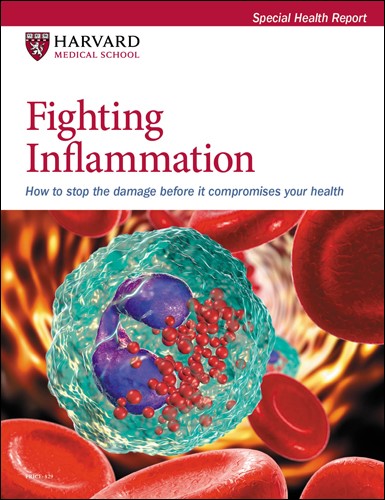Chronic inflammation and your joints
Why the immune system is sometimes the culprit in joint pain.
 When you suffer a joint injury — maybe a banged-up knee or a twisted ankle — a little inflammation is part of the healing process. Puffy, red, tender joints may indicate that your immune system is working to remove damage and promote the growth of new tissue, a healthy kind of inflammation. But sometimes the immune system launches unhealthy, chronic inflammation in the joints, for no apparent reason. This leads to pain, stiffness, and joint damage known as inflammatory arthritis.
When you suffer a joint injury — maybe a banged-up knee or a twisted ankle — a little inflammation is part of the healing process. Puffy, red, tender joints may indicate that your immune system is working to remove damage and promote the growth of new tissue, a healthy kind of inflammation. But sometimes the immune system launches unhealthy, chronic inflammation in the joints, for no apparent reason. This leads to pain, stiffness, and joint damage known as inflammatory arthritis.
The attack on joints
It’s often unknown what triggers the immune system to unleash an assault on the joints, but we do know what the cells are up to once they’re in action.
"In a common type of inflammatory arthritis like rheumatoid arthritis, a variety of immune cells can be found in the lining and fluid of the joint. These cells attract other immune cells and together lead to thickening of the joint lining, new blood vessel formation, and — ultimately — joint damage," says rheumatologist Dr. Robert Shmerling, medical editor of the Harvard Special Health Report Fighting Inflammation (/ui).
Chronic inflammation in the joints can damage cartilage, bones, tendons (which attach muscle to bones), or ligaments (which hold joints together); irritate nerves; and produce a long list of symptoms, including pain, swelling, and stiffness. The joint damage may be progressive and irreversible.
Types
There are many types of inflammatory arthritis. Common ones include these:
Rheumatoid arthritis (RA). RA occurs when the immune system attacks the lining of the joints, especially in the hands, wrists, and feet. RA may also affect the heart, lungs, and eyes.
Gout. Gout is characterized by a buildup of uric acid, which can form crystals in the joints — especially in the big toe, and sometimes in the hands, wrists, or knees. The crystals activate a temporary inflammatory response that can become chronic.
Calcium pyrophosphate deposition disease (CPPD, or pseudogout). In CPPD, calcium crystals settle in the joints, especially the knee, wrist, shoulder, ankle, or elbow. Like the uric acid crystals in gout, the calcium crystals in CPPD prompt the body to respond with inflammation; over time, this may become chronic.
Psoriatic arthritis. About 30% of people with psoriasis (an autoimmune condition that causes raised patches of scaly skin) develop psoriatic arthritis, which can affect the knees, ankles, wrists, or fingers.
What about osteoarthritis?
Osteoarthritis, a wearing away of the smooth cartilage lining joints, has long been considered a noninflammatory form of arthritis. "But we now recognize that some inflammatory cells are present in osteoarthritis, although the inflammation is usually much less dramatic than in rheumatoid arthritis or other types of inflammatory arthritis," Dr. Shmerling says.
The finding of mild chronic inflammation in osteoarthritis has been significant enough for researchers to begin investigating whether the condition can be treated with some of the same types of medications used to treat inflammatory arthritis.
Treatment
Many types of drugs are used to treat inflammatory arthritis. They include
- nonsteroidal anti-inflammatory drugs (NSAIDs), such as ibuprofen (Advil, Motrin), which reduce levels of prostaglandins — chemicals that promote inflammation
- oral or injected steroids, which reduce inflammation and suppress the immune system
- injections or intravenous infusions of nonbiologic disease-modifying antirheumatic drugs (DMARDs), such as methotrexate (Rheumatrex, Trexall), which suppress the immune system
- injections or infusions of biologic DMARDs, antibodies such as adalimumab (Humira) that suppress the immune system in a more targeted way than nonbiologic DMARDs
- Janus kinase inhibitors, such as tofacitinib (Xeljanz), which interrupt inflammatory signals
- drugs that lower uric acid levels (for gout).
Results with drug treatment are often good. "Medications to lower uric acid can essentially eliminate gout. And the development of newer drugs for rheumatoid arthritis, including biologics and Janus kinase inhibitors, makes it possible for far more people than in the past to experience remission and protection from ongoing joint damage," Dr. Shmerling says.
Other ways to live with arthritis
Other ways to help reduce pain and inflammation include exercising, avoiding processed foods (which promote inflammation), reducing stress, not smoking, and getting enough sleep. Wearing a splint or brace on affected joints and seeking physical therapy may also ease your pain and keep you mobile and active.
Image: © SelectStock/Getty ImagesAbout the Author

Heidi Godman, Executive Editor, Harvard Health Letter
Disclaimer:
As a service to our readers, Harvard Health Publishing provides access to our library of archived content. Please note the date of last review or update on all articles.
No content on this site, regardless of date, should ever be used as a substitute for direct medical advice from your doctor or other qualified clinician.
















